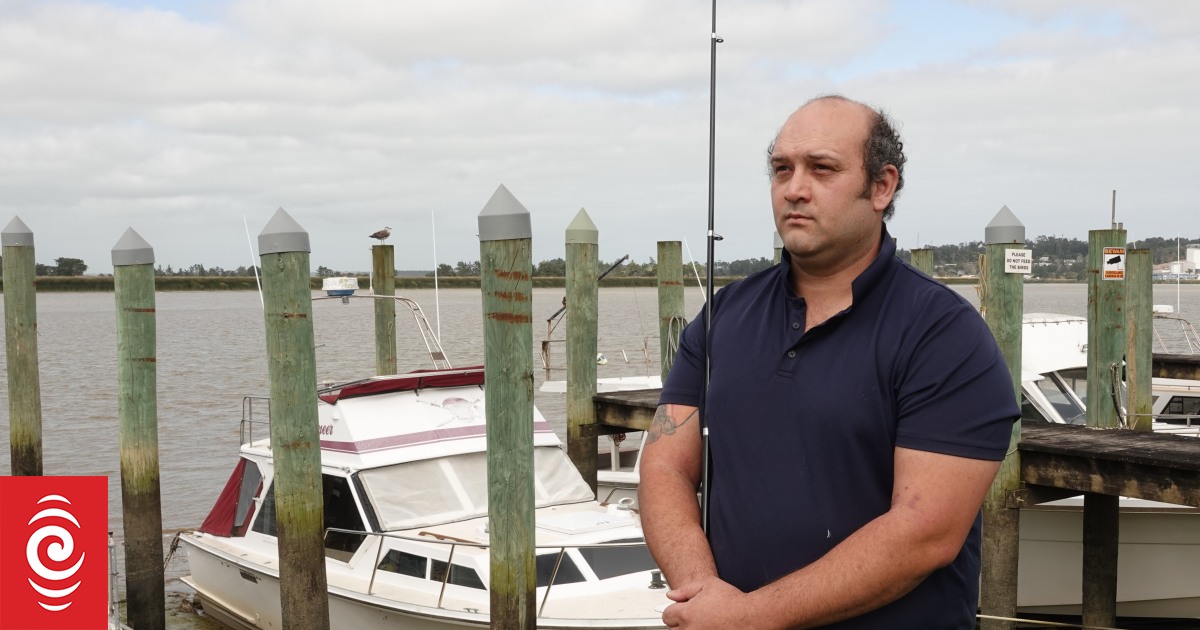
The Northern Wairoa River, seen here flowing through Dargaville, is Northland’s longest river.
Photo: Peter de Graaf/RNZ
When Sam Erickson started hooking one sickly snapper after another he knew something was seriously wrong.
Around November last year the Dargaville stay-at-home dad noticed a change in the fish he pulled out of the Northern Wairoa River.
“We didn’t think too much of them, until we started catching a lot of them. Probably eight out of 10 snapper we were pulling in were diseased.”
Erickson was the first to coin the term ‘zombie fish’, a name that’s caught on everywhere the hollow-eyed, lethargic fish have been caught.

Dargaville fisherman Sam Erickson came up with the name “zombie fish”.
Photo: Peter de Graaf/RNZ
“They very much look like zombies. The first sign is they start losing all that gel around their eyes, so a cavity opens up around their eyeballs. Their eyes start developing cataracts and there’s often a bloodshot line in there, which is a sign of stress.”
While the cause of zombie fish is not yet known, the phenomenon has put a spotlight on Northland’s longest river – and what that reveals isn’t pretty.
A 2020 report by the Northland Regional Council described water quality in the river as “particularly poor”, with standards breached for almost every pollutant, including nitrates, ammonia and phosphorus.
The river was also high in E. coli, a type of bacteria associated with sewage, and especially afflicted by sediment.
The Northern Wairoa is sometimes called the upside-down river, because its permanently brown colour makes it look like the muddy riverbed is on top.

Dargaville Ratepayers and Residents Association chairwoman Rose Dixon.
Photo: Peter de Graaf/RNZ
Rose Dixon, chairwoman of the Dargaville Ratepayers and Residents Association, said she first heard about zombie fish at the group’s inaugural meeting earlier this year.
“One of the blokes at the meeting, he was fisherman, he mentioned he’d been catching zombie fish. And then another bloke piped up and said, ‘I’ve been catching zombie fish too’. And I thought to myself, ‘holy heck, what’s going on?’.”
Dixon encouraged Erickson to go public with his concerns about the fish he was catching, which prompted an Auckland water testing business to offer free tests of the Northern Wairoa at various sites around Dargaville.
High levels aluminium
Those tests revealed – apart from the usual pollutants – surprisingly high levels of aluminium in the water, far above the levels recommended by the Australia and New Zealand Environment and Conservation Council for the health of fish and aquatic plants.
The results were a surprise because the Northland Regional Council does not routinely test for aluminium, which is not expected at such high levels in a rural waterways.
The council’s own follow-up tests detected even higher levels of the metal.
It was not clear why there were such high levels of aluminium in the river, though it did occur naturally in Kaipara soils and was commonly used to clarify water, for example in treatment plants or earthworks settling ponds.

Snow Tane, general manager of Te Roroa Development Group.
Photo: Peter de Graaf/RNZ
Snow Tane, general manager of Te Roroa Development Group, said iwi had long been concerned about water quality in the awa.
“The main reason is around health and well-being. There are a lot of things associated with the mauri [life force] of the river, and it’s a mahinga kai – that means our people have traditionally gone to the river and got food resources from it. In particular fish, and further down you get oysters and mussels.”
Tane said long-standing concerns included the large volumes of sediment in the river and the discharge of untreated waste water, for example during Cyclone Gabrielle.
He said a plan was needed, and soon.
“That plan needs to be around understanding where it’s coming from, and how can we put mitigation and processes in place to not only manage it, but to find ways to stop it from occurring.”
Dixon said there was hope for an improvement in the river’s sediment problem, with Kaipara Moana Remediation – New Zealand’s biggest harbour restoration project – working to clean up the water flowing into the Northern Wairoa and the Kaipara Harbour.
The project had so far overseen the planting of almost two million trees and the more than 800km of fencing to keep stock out of waterways.
That, would, however take time to make a difference.
Dixon said there were also problems with the town’s wastewater treatment plant, which regularly breached its consent conditions.
She believed the plant should be upgraded but that could come at huge cost, beyond the means of Dargaville’s small ratepayer base.
She said central government assistance could be needed both to fix the town’s sewage plant and to address the river’s high aluminium levels.
“When you think about the fact that more than 90 percent of the west coast’s snapper spawns here in our river, maybe it’s an issue of national significance and the government perhaps needs to step in and look at what they can do to help.”
‘It’s crap’

Photo: Peter de Graaf/RNZ
Erickson was blunt when asked about the state of the river.
“It’s crap. We crap into it – that’s where all our septic goes.”
However, the importance of the river to local people was illustrated by a Nathan, a young Dargaville builder, who stopped to talk after overhearing RNZ conducting an interview about the Northern Wairoa.
He said it was much more than just a wide, muddy waterway.
“If you ask anyone who lives or was raised around this area, they’ll say that the river is part of their life. Growing up here, you’re either fishing or spending time on the water on the beaches. It becomes part of your blood.”
David Sinclair, the region’s top public health officer, is planning to meet Dargaville iwi and residents in coming weeks to hear their concerns first-hand.



